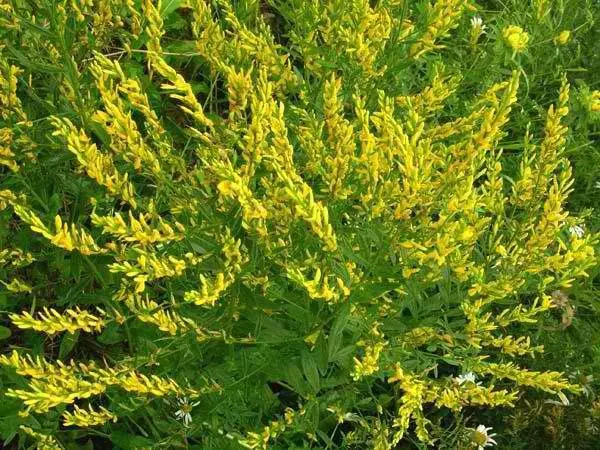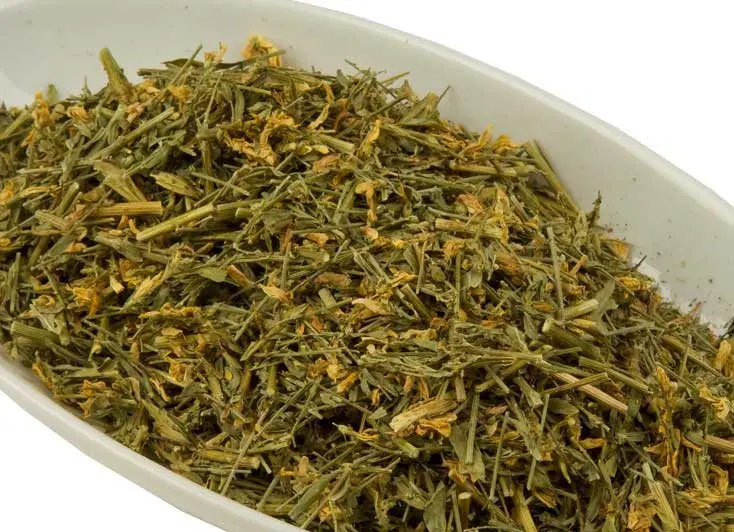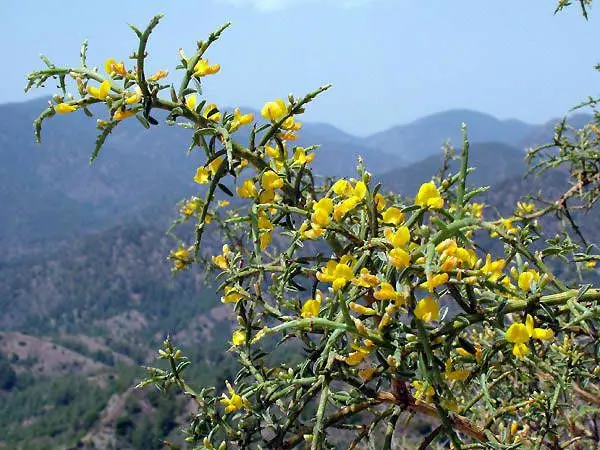Contents
Properties and use of gorse, yellow, Spanish
Botanical characteristics of dyer’s gorse

Gorse – low shrub from the legume family. Its erect or creeping stems reach a length of 30-150 cm and each of them is covered with adpressed hairs. The leaves are lanceolate, have short petioles, and yellow flowers are collected at the tops of the stems in dense brushes. The flowering period of the plant is from June to July, the fruits ripen in August-September. The fruits are flat bare beans up to three cm long, the seeds are elliptical in shape, dark brown in color.
Gorse grows in the European part of Russia, the Caucasus, Western Siberia and Central Asia, preferring sandy or calcareous soils on hillsides, dry forests and pine forests. The plant is light-loving and drought-resistant, hardly tolerates waterlogging and severe frosts.
Useful properties of gorse
The healing properties of gorse have long been known in folk medicine; flowers, roots and grass of the plant are collected for medicinal purposes. The aerial part is usually harvested during the flowering period of the gorse, the roots are dug up in the fall. Drying is carried out on the street under shady canopies or indoors with free air access. The shelf life of the collection is 1 year. For drying, you can also use special dryers with an optimal temperature regime of 45-50 ° C.
Gorse dye is used as a hemostatic, choleretic, tonic, vasodilator and antibacterial agent. The composition of the plant includes alkaloids, essential oil, glycosides, tannins, flavonoids, organic acids. The flowers contain coloring pigments – luteolin and genistein.
The use of gorse

The aerial part of the plant in the form of decoctions and infusions is used in the treatment of hepatitis, cystitis, allergic dermatitis, rheumatism, rickets, furunculosis. Decoctions and infusions help with edema of renal and cardiac origin, thyroid diseases, bone fractures, salt deposits, ringworm and some venereal diseases. In Ukraine, gorse flowers and grass are used in the treatment of bronchial asthma. In the USA, flowers and seeds are used in the complex treatment of malignant tumors.
Infusions from the aerial part of the gorse have an antibacterial and vasoconstrictive effect, they can be used to rinse the mucous membrane of the mouth and throat. Fresh leaves and fruits help to get rid of warts and calluses. Decoctions from the root of the gorse are used in folk medicine in the treatment of malaria, heart weakness, jaundice, and thyroid diseases. Gorse root has proven itself as a means for removing chlorides from the body, it helps with salt diathesis and constipation.
Infusion prepared at the rate of 1 tablespoon of herbs for 2 cups of boiling water. It is necessary to insist the remedy for at least two hours, after filtering it should be taken 1 tablespoon 3 times a day. The exact dosage must be observed!
decoction prepared at the rate of 15 g of chopped grass and gorse flowers per 500 mg of boiled water. Boil the composition in a steam bath by 1/3 of the volume, then cool and strain through 2-3 layers of gauze. Dosage – 2 tablespoons every other day, every two hours until the desired effect is achieved. A decoction is used as a choleretic, diuretic and laxative.
Gorse flowers
Gorse is becoming increasingly popular in ornamental horticulture, while garden forms differ from wild-growing counterparts in the height of the bush, the direction of growth of the stems and the presence of double flowers. This drought-resistant plant is used in landscaping singly and in groups, it is often planted on rocky areas and slopes, on alpine hills and borders.
Gorse is also notable for the fact that a persistent yellow dye was once obtained from its flowers, which was used to dye woolen and linen fabrics. The paint was of particular importance in the production of carpets; it was used for dyeing carpet threads. Hence the name of the plant – “dyeing gorse”. Gorse shoots are a good material for floristic compositions, although they belong to a group of plants of little importance.
Gorse yellow
This low, non-thorny shrub grows up to 1 meter high. It has thin, slightly branched shoots covered with oblong leaves (up to 2,5 cm long). The flowers are yellow, odorless, collected in apical brushes. The duration of flowering is 40-60 days, the fruits ripen in early autumn. The fruit is an oblong and laterally compressed bean, up to three cm long. Yellow gorse loves sunny places and infertile calcareous soils. Grows in pine forests, steppes, clearings and meadows. The plant is propagated by cuttings and seeds.
Gorse is widely used in folk medicine as a medicinal plant. Decoctions and infusions from it have choleretic, tonic, antibacterial, soothing and hemostatic properties. With the help of infusions from the gorse, thyroid diseases, uterine bleeding, malaria, rheumatism, ringworm, furunculosis, liver and urinary tract diseases, arthritis, gout are treated.
From the roots make diuretics to relieve swelling of cardiac and renal origin. Decoctions of the root help with the deposition of salts in the joints. With the help of fresh leaves and flowers, dry warts and calluses are removed.
Gorse spanish
The birthplace of this type of gorse is the rocky slopes of the mountains in Spain and France, from where it was brought to Russia. This is a perennial shrub with straight and prickly stems at the base, the height of which can reach two to three meters. Small leaves about 1 cm long fit snugly to rounded stems. During the flowering period, bright yellow large flowers (more than 1 cm) form apical inflorescences. Gorse Spanish grows well and blooms in any well-drained soil in a sunny place.
In terms of its therapeutic effect, this species is similar to dyeing gorse, therefore it is also used in homeopathy and traditional medicine. Decoctions, infusions and ointments from it are effective in the treatment of the thyroid gland, salt deposition, bone fractures, rheumatism, gout. The components of the gorse are part of the candles for hemorrhoids. It is used for bronchial asthma, ringworm, furunculosis, arthritis.
For skin diseases (abscesses, scrofula, lichen), an infusion of herbs can be applied externally – in the form of local baths and rubbing. Gorse helps with warts and dry calluses. Herbal preparations are also used as an antibacterial, diuretic, choleretic and general tonic.
A prickly gorse

This thorny shrub is used to fill rocky and sandy soils and as a hedge. It grows well in sunny or slightly shaded areas. The gorse has yellow flowers and thorny branches at the base, its height reaches 60 cm. Almost every shoot ends with a brush of flowers up to 5–7 cm long. The fruits ripen in early October, and shoots continue to grow until the onset of frost.
In terms of its chemical composition and effect on the human body, prickly gorse is similar to dyer gorse, which is why it is also used in folk medicine. For medicinal purposes, collect grass, flowers, leaves and roots of the plant. Decoctions and infusions of prickly gorse are used as a blood-purifying, anti-inflammatory, antiseptic, choleretic and diuretic.
Contraindications to the use of gorse
Gorse dye belongs to poisonous plants, therefore, when taking preparations from it, it is necessary to strictly observe the dosage. It is strictly contraindicated in patients with high blood pressure, pregnant women, patients with coronary heart disease and people with severe liver disease. If the dosage is incorrect, the following signs of gorse poisoning may occur: headache, nausea, dizziness, vomiting.









